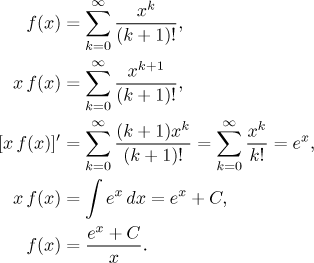
Problem: Sum up the following power series:

Solution: We do not know any series whose coefficients would consist of several parts, so we first need to somehow handle this problem. There are essentially two ways. We could try to rewrite each coefficient as one term and then take it from there. The other option is to split the series into two. What would be the better choice? When we picture the outcome of merging the two parts of a coefficient (using common denominator), we see that it is definitely not something that we would want to mess with. On the other hand, the individual parts in that difference are really nice, so this second approach is definitely better.

The first series is simple to sum up, since it is a geometric series.

Now we will look at the second series. We need to turn it into some series that we already know. Since it contains all powers, the sine or cosine series do not seem like a good idea, and since we do not know how to get rid of factorials, we are left with a series that features all powers and also factorials: The exponential series.
The only trouble is that we do not have exactly

Now we have two problems, the power and the first index do not fit. The power can be easily changed when we divide and multiply this last series by x, the missing first term in the exponential series can be filled in using the add-subtract trick. As usual we will use the traditional k instead of n. Since we will only be using algebraic operations, we will write it using the easier way - a chain of equalities.

We have little trouble at 0, but this is no problem. The question reads "sum
up the series", so we simply put 0 into the given series and get the answer
that way.
Conclusion:

Alternative:
What is the other way in which we can work out the second series? Our
problem is the factorial of

What is C? The usual way to find out is to put some number for
x on both sides of the last equality, and recall that f stands
for the given series. When we look at it, we see that the only x for
which we can evaluate this series is
To get out of this situation we need to apply some knowledge of functions.
When we look at the second last line, we see equality between two functions
that is true on an interval except a point in its middle, namely they are
equal on some reduced neighborhood of 0. Therefore these two functions have
to have the same limit at 0, and because they are continuous, they have to
be equal at 0. Thus we conclude that the second last line can be also used
when